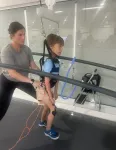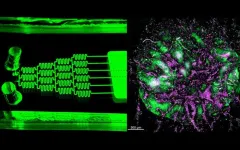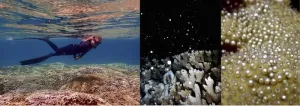(Press-News.org) Updated Guideline Highlights:
The American Heart Association and the American Academy of Pediatrics update recommendations for untrained lay rescuers and trained rescuers resuscitating adults and children who have drowned.
One important update is the recommendation to provide cardiopulmonary resuscitation (CPR) with rescue breaths and chest compressions to all persons in cardiac arrest following drowning after removal from the water.
The updated recommendations for resuscitation following drowning are, for the first time, well codified, accompanied by systematic reviews of the literature and presented in a comprehensive publication.
A majority of the focused update includes new topics that the Association has not previously addressed with treatment recommendations, such as oxygen administration after drowning, automated external defibrillator (AED) use in cardiac arrest after drowning, public-access defibrillation programs and prehospital respiratory support with or without equipment.
Future research is needed to identify drowning resuscitation best practices using standardized drowning event reporting and evaluation of outcomes, as well as effective drowning prevention programs, especially in resource-limited regions.
Embargoed until 4 a.m. CT/5 a.m. ET, Tuesday, Nov. 12, 2024
DALLAS, Nov. 12, 2024 — Updated guidance reaffirms the recommendation for cardiopulmonary resuscitation (CPR) and highlights the importance of compressions with rescue breaths as a first step in responding to cardiac arrest following drowning, according to a new, focused update to Special Circumstances Guidelines from the American Heart Association and the American Academy of Pediatrics. The organizations have previously partnered on neonatal guidelines, however, this is the first collaboration on resuscitation after drowning. The recommendations are published today simultaneously in the flagship, peer-reviewed journals of each organization, Circulation and Pediatrics. The publication in Pediatrics focuses on resuscitation of children following drowning and references pediatric literature, while the publication in Circulation is for resuscitation of both adults and children and includes literature addressing both populations.
Drowning is the third-leading cause of death from unintentional injury worldwide. The World Health Organization estimates there are about 236,000 deaths due to drowning each year globally. According to the CDC, it’s the number one cause of death for children ages 1-4 years old in the U.S.
Disparities in access to swim lessons and other preventive strategies have created inequities; among children ages 17 and younger, U.S. drowning rates are highest among Black and American Indian and Alaska Native individuals.
“The focused update on drowning contains the most up-to-date, evidence-based recommendations on how to resuscitate someone who has drowned, offering practical guidance for health care professionals, trained rescuers, caregivers and families,” said writing group Co-Chair Tracy E. McCallin, M.D., FAAP, associate professor of pediatrics in the division of pediatric emergency medicine at Rainbow Babies and Children’s Hospital in Cleveland. “While we work on a daily basis to lower risks of drowning through education and community outreach on drowning prevention, we still need emergency preparedness training that can be used in tragic circumstances if a drowning occurs.”
Detailed in the new guideline update:
Anyone removed from the water without showing signs of normal breathing or consciousness should be presumed to be in cardiac arrest.
Rescuers should immediately initiate CPR that includes rescue breathing in addition to chest compressions. Multiple large studies over time show more people with cardiac arrest from non-cardiac causes such as drowning survive when CPR includes rescue breaths compared to Hands-Only CPR (calling 911 and pushing hard and fast in the center of the chest).
Drowning generally progresses quickly from initial respiratory arrest (when a person is unable to breathe) to cardiac arrest, meaning that the heart stops beating. As a result, blood cannot circulate properly throughout the body, and it is starved of oxygen.
“CPR for cardiac arrest due to drowning must focus on restoring breathing as well as restoring blood circulation,” said writing group Co-Chair Cameron Dezfulian, M.D., FAHA, FAAP, senior faculty in pediatrics and critical care at Baylor College of Medicine in Houston.
“Cardiac arrest following drowning is most often due to severe hypoxia, or low blood oxygen levels,“ Dezfulian said. ”This differs from sudden cardiac arrest from a cardiac cause where the individual generally collapses with fully oxygenated blood.”
The updated guidance advises untrained rescuers and the public to:
Provide CPR with breaths and compressions to all people who have a cardiac arrest after drowning. If a person is untrained, unwilling, or unable to give breaths, they can provide chest compressions only until help arrives.
In-water rescue breathing should be given only by rescuers trained in this special skill if it doesn’t compromise their own safety. Trained rescuers should also provide supplemental oxygen if available.
The initiation of CPR should always be prioritized and begin as soon as possible as early lay responder CPR has been shown to improve outcomes from drowning.
The writing group recommends an automated external defibrillator (AED) should be placed in public facilities where aquatic activities are present such as swimming pools or beaches. They can be used once the person is removed from the water, if available, yet should not delay initiation of CPR. If available, the AED should be connected to the patient to assess for shockable rhythms once CPR is ongoing. Although most cases of cardiac arrest following drowning do not have shockable rhythms, if a primary cardiac event such as a heart attack occurs while in the water, the best outcomes are when defibrillation is done quickly. AED use is safe and feasible in aquatic environments.
All individuals requiring any level of resuscitation following drowning, including those who only need rescue breaths, should be transported to a hospital for evaluation, monitoring and treatment.
In addition to the recommendations on drowning resuscitation, the guideline update also highlights the Drowning Chain of Survival, which includes the steps needed to improve chances of survival: prevention, recognition and safe rescue.
Prevention
It has been estimated that more than 90% of all drownings are preventable. Research has found most infants drown in bathtubs, and the majority of preschool-aged children drown in swimming pools. The American Heart Association and the American Academy of Pediatrics recommend being water aware and practicing water safety. A full review of prevention is outside the scope of this guideline, however, the topic is addressed in the American Academy of Pediatrics 2021 technical report, Prevention of Drowning, and in guidelines from the World Health Organization and the Wilderness Medical Society.
Recognition
Recognition of drowning may be challenging because someone who is drowning may not be able to verbalize distress or signal for help. Drowning happens quickly. People in distress will rapidly submerge, lose consciousness and may be hidden from anyone not actively seeking them.
Safe Rescue and Removal
The guideline update recommends that appropriately trained rescuers, such as lifeguards, swim instructors or first responders, should provide in-water rescue breathing to an unresponsive person who has drowned if it does not compromise their own safety. Previous studies have proven this leads to more favorable survival outcomes. A drowning person who is unconscious and likely in cardiac arrest should be removed from the water in a near-horizontal position, with the head maintained above body level and airway open. If the drowning individual is conscious, a more vertical position may be preferable to reduce the risk of vomiting.
In summary, “These updated guidelines are based on the latest available evidence and are designed to inform trained rescuers and the public how to proceed in resuscitating people who have drowned. Drowning can be fatal. Our recommendations maximize balancing the need for rapid rescue and resuscitation, while prioritizing rescuer safety,” Dezfulian said.
The American Heart Association urges all individuals to enroll in CPR training programs available through its online platform or local community centers. CPR education and training is offered for health care professionals, first responders, individuals, schools and communities. Provision of good rescue breathing requires hands on practice using a manikin or other simulation training.
This joint focused update was prepared by the volunteer writing group on behalf of the American Heart Association and the American Academy of Pediatrics. These updates to current clinical guidelines were developed with input from experts in drowning, pediatrics, adult and pediatric critical care, anesthesiology, emergency medicine, EMS and related fields. It is based on seven systematic reviews completed by the International Liaison Committee on Resuscitation Basic Life Support Task Force, used to generate updated treatment recommendations and good practice statements. This guideline update supersedes the American Heart Association’s prior recommendations for drowning issued in 2020 and serves as a complement to the American Academy of Pediatrics 2021 Prevention of Drowning technical report and the related 2019 Prevention of Drowning policy statement. All other recommendations and algorithms published in the 2020 American Heart Association Guidelines for CPR and Emergency Cardiovascular Care remain the official clinical recommendations for resuscitation outside the special circumstance of drowning.
Additional members of the writing group are Joost Bierens, M.D., Ph.D.; Cody L. Dunne, M.D.; Ahamed H. Idris, M.D., FAHA; Andrew Kiragu, M.D., FAAP; Melissa Mahgoub, Ph.D.; Rohit P. Shenoi, M.D., FAAP; David Szpilman, M.D.; Mark Terry, M.P.A., N.R.P.; Janice A. Tijssen, M.D., M.Sc., FAHA; Joshua M. Tobin, M.D., M.Sc.; and Alexis A. Topjian, M.D., M.S.C.E., FAHA. Authors’ disclosures are listed in the manuscript.
Both the American Heart Association and the American Academy of Pediatrics have strict policies to prevent conflicts of interest from influencing scientific content. The Association receives funding primarily from individuals. Foundations and corporations (including pharmaceutical, device manufacturers and other companies) also make donations and fund specific Association programs and events. Revenues from pharmaceutical and biotech companies, device manufacturers and health insurance providers, and the Association’s overall financial information are available here.
Additional Resources:
Available multimedia is on right column of release link.
View the manuscript online.
AHA news release: Impact Update: CPR willingness grows in the U.S., need to act remains (June 2024)
Summer safety starts with CPR
Swim Lessons: When to Start and What Parents Should Know
Join the Nation of Lifesavers
Find a CPR course
AED Implementation
Today You Were Ready CPR PSA
AAP Prevention of Drowning Technical Report
AAP Drowning Prevention Campaign Toolkit
Follow AHA/ASA news on X @HeartNews
Follow AAP news on social media @AAPNews
###
About the American Heart Association
The American Heart Association is a relentless force for a world of longer, healthier lives. We are dedicated to ensuring equitable health in all communities. Through collaboration with numerous organizations, and powered by millions of volunteers, we fund innovative research, advocate for the public’s health and share lifesaving resources. The Dallas-based organization has been a leading source of health information for a century. During 2024 - our Centennial year - we celebrate our rich 100-year history and accomplishments. As we forge ahead into our second century of bold discovery and impact, our vision is to advance health and hope for everyone, everywhere. Connect with us on heart.org, Facebook, X or by calling 1-800-AHA-USA1.
About the American Academy of Pediatrics
The American Academy of Pediatrics is an organization of 67,000 primary care pediatricians, pediatric medical subspecialists, and pediatric surgical specialists whose mission is to attain optimal physical, mental, and social health and well-being for all infants, children, adolescents, and young adults. For frequent updates on AAP recommendations, Pediatrics studies, AAP in the news, public awareness campaigns, information for parents and more, follow us on social media @AmerAcadPeds. For parent-friendly health information from the AAP, visit www.HealthyChildren.org. Follow HealthyChildren on social media @HealthyChildren.
END
Updated guidance reaffirms CPR with breaths essential for cardiac arrest following drowning
New joint update from the American Heart Association and the American Academy of Pediatrics details latest guidelines for resuscitation following drowning.
2024-11-12
ELSE PRESS RELEASES FROM THIS DATE:
Study reveals medical boards rarely discipline physician misinformation
2024-11-12
Despite increased concerns about doctors spreading false medical claims during the COVID-19 pandemic, medical boards rarely take disciplinary action against physicians for spreading misinformation, according to a new study by Richard S. Saver, Arch T. Allen Distinguished Professor of Law at the University of North Carolina School of Law and Professor in the Department of Social Medicine at the UNC School of Medicine, published in JAMA Network Open.
Through analysis of over 3,100 medical board disciplinary proceedings across the nation’s five most populous states, Saver found that spreading misinformation to the public was the least common reason for ...
New treatment helps children with rare spinal condition regain ability to walk
2024-11-12
BALTIMORE, November 12, 2024— Researchers at Kennedy Krieger Institute’s International Center for Spinal Cord Injury (ICSCI) have made a remarkable advancement in treating children with Acute Flaccid Myelitis (AFM), a rare but severe neurological condition that causes sudden paralysis.
A new study, published in the journal Children, demonstrates that a combination of Transcutaneous Spinal Cord Stimulation (TSS) and movement training can help children with AFM improve their ability to walk. TSS is a non-invasive therapy ...
'Grow Your Own' teacher prep pipeline at the University of Louisiana at Lafayette funded by US Department of Education
2024-11-12
A new teacher prep initiative from the University of Louisiana at Lafayette’s College of Education & Human Development received a $3.1 million grant from the U.S. Department of Education’s Teacher Quality Partnership grant program to establish and strengthen a Grow Your Own Network across Acadiana.
This initiative, designed to address teacher shortages in the south-central region of Louisiana, will build a regional network connecting local school districts with higher education institutions ...
Lab-grown human immune system uncovers weakened response in cancer patients
2024-11-12
To better understand why some cancer patients struggle to fight off infections, Georgia Tech researchers have created tiny lab-grown models of human immune systems.
These miniature models — known as human immune organoids — mimic the real-life environment where immune cells learn to recognize and attack harmful invaders and respond to vaccines. Not only are these organoids powerful new tools for studying and observing immune function in cancer, their use is likely to accelerate vaccine development, better predict disease treatment response for patients, and even speed up clinical trials.
“Our synthetic ...
More than 5 million Americans would be eligible for psychedelic therapy, study finds
2024-11-12
Acupuncture. Ketamine infusions. “Electroshock” or electroconvulsive therapy. The existing treatment options for those diagnosed with Major Depressive Disorder (MDD) and Treatment-Resistant Depression (TRD), may sometimes feel daunting or expensive alternatives to medication. However, a groundbreaking study from Emory University demonstrates how psilocybin-assisted therapy could impact more than 5 million people in the U.S. pending approval from the FDA.
The findings highlight both the ...
Children’s Hospital of Philadelphia researchers find community health workers play critical role in coordinating asthma care across home, school and community
2024-11-12
While great strides have been made to ensure children have access to proper asthma care in their home and community, linking those environments to the care that children receive while in school has been a challenge. In a new study, researchers from Children’s Hospital of Philadelphia (CHOP) demonstrate that community health workers can play a critical role in integrating all environments where children encounter asthma triggers, and care coordination provided by these workers may be a cost-effective way to achieve that. The findings were recently published by JAMA ...
Comprehensive Genomic Profiling leads to better patient outcomes, new joint study says
2024-11-12
RENTON, Wash. [Nov. 12, 2024] – New real-world data from Providence, Illumina (NASDAQ: ILMN), and Microsoft Research reveals that Comprehensive Genomic Profiling (CGP), when done early in a cancer patient’s diagnosis, leads to better personalized treatment and patient outcomes. The findings come out of the first two years of a five-year, real-world study, which was published today in the Journal of Clinical Oncology - Oncology Practice (JCO-OP).
Through a novel approach, the study employed pathologist-driven CGP testing ...
Animated movie characters with strabismus are more likely to be villains, study finds
2024-11-12
Strabismus, a misalignment of the eyes that occurs especially in children, has no bearing on intelligence or personality, but animated movies tend to use the condition to signify a villainous, dopey, or clumsy character, according to a new study from researchers at the University of Colorado School of Medicine.
“When animators are figuring out what a character is going to look like, they have to decide on every little detail of that character's appearance, and so it's not by chance that an animated character happens to have strabismus,” says Michael ...
How retailers change ordering strategy when a supplier starts its own direct channel
2024-11-12
Researchers from Erasmus University and KU Leuven published a new Journal of Marketing study that examines how retailers respond when suppliers establish direct channels to reach end-consumers and how suppliers can take steps to avoid a backlash.
The study, forthcoming in the Journal of Marketing, is titled “How Retailers Change Ordering Strategies When Suppliers Go Direct” and is authored by Michiel Van Crombrugge, Els Breugelmans, Femke Gryseels, and Kathleen Cleeren.
Recently, Sony began selling PlayStation products through its PlayStation Direct online store in the UK, ...
Young coral use metabolic tricks to resist bleaching
2024-11-12
Coral larvae reduce their metabolism and increase nitrogen uptake to resist bleaching in high temperatures, according to a study published November 12th in the open-access journal PLOS Biology by Ariana S. Huffmyer of the University of Washington, US, and colleagues.
High ocean temperatures cause coral bleaching, which results from the disruption of the relationship between corals and their symbiotic algae, an increasing concern as global temperatures rise. However, relatively little research has examined the effects of high temperatures ...
LAST 30 PRESS RELEASES:
A new way to map how cells choose their fate
Numbers in our sights affect how we perceive space
SIMJ announces global collaborative book project in commemoration of its 75th anniversary
Air pollution exposure and birth weight
Obstructive sleep apnea risk and mental health conditions among older adults
How talking slows eye movements behind the wheel
The Ceramic Society of Japan’s Oxoate Ceramics Research Association launches new international book project
Heart-brain connection: international study reveals the role of the vagus nerve in keeping the heart young
Researchers identify Rb1 as a predictive biomarker for a new therapeutic strategy in some breast cancers
Survey reveals ethical gaps slowing AI adoption in pediatric surgery
Stimulant ADHD medications work differently than thought
AI overestimates how smart people are, according to HSE economists
HSE researchers create genome-wide map of quadruplexes
Scientists boost cell "powerhouses" to burn more calories
Automatic label checking: The missing step in making reliable medical AI
Low daily alcohol intake linked to 50% heightened mouth cancer risk in India
American Meteorological Society announces Rick Spinrad as 2026 President-Elect
Biomass-based carbon capture spotlighted in newly released global climate webinar recording
Illuminating invisible nano pollutants: advanced bioimaging tracks the full journey of emerging nanoscale contaminants in living systems
How does age affect recovery from spinal cord injury?
Novel AI tool offers prognosis for patients with head and neck cancer
Fathers’ microplastic exposure tied to their children’s metabolic problems
Research validates laboratory model for studying high-grade serous ovarian cancer
SIR 2026 delivers transformative breakthroughs in minimally invasive medicine to improve patient care
Stem Cell Reports most downloaded papers of 2025 highlight the breadth and impact of stem cell research
Oxford-led study estimates NHS spends around 3% of its primary and secondary care budget on the health impacts of heat and cold in England
A researcher’s long quest leads to a smart composite breakthrough
Urban wild bees act as “microbial sensors” of city health.
New study finds where you live affects recovery after a hip fracture
Forecasting the impact of fully automated vehicle adoption on US road traffic injuries
[Press-News.org] Updated guidance reaffirms CPR with breaths essential for cardiac arrest following drowningNew joint update from the American Heart Association and the American Academy of Pediatrics details latest guidelines for resuscitation following drowning.




